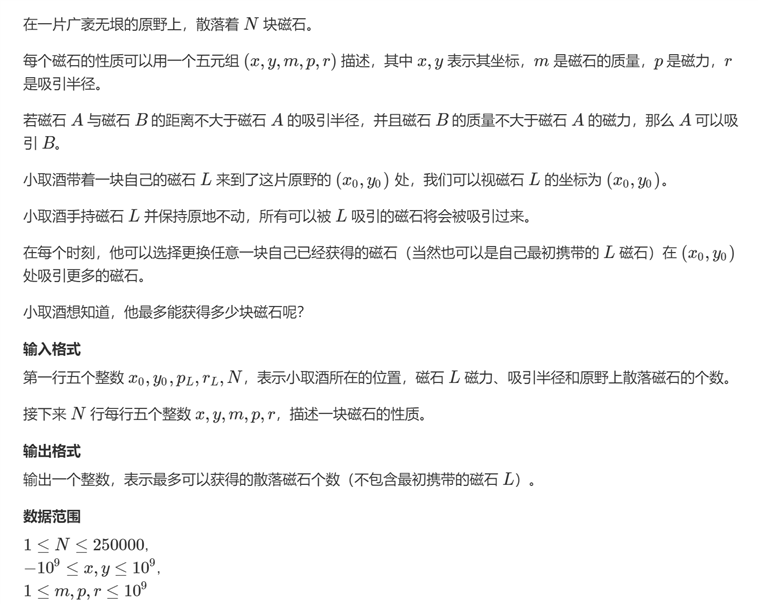ACWing 250 磁力块

考虑BFS,先将\(L\)加入队列,然后每次将其能吸引的磁石加入队列\(_{[1]}\),最后进入过队列的数\(-1\)(因为答案不包含最初携带的磁石\(L\))即为所求。
考虑如何找到哪些能吸引的磁石?
枚举每个磁石,判断其能不能被吸引。
# include <bits/stdc++.h>
using namespace std;
typedef long long ll;
const int N = 250005;
struct node
{
ll x,y,m,p,r;
node() {}
node(ll _x,ll _y,ll _m,ll _p,ll _r) : x(_x),y(_y),m(_m),p(_p),r(_r) {}
}a[N],L;
int n;
bool vis[N];
double dist(node a,node b)
{
return sqrt((a.x - b.x) * (a.x - b.x) + (a.y - b.y) * (a.y - b.y));
}
bool check(node a,node b) // a xi b
{
if(double(a.r) < dist(a,b)) return 0;
if(b.m > a.p) return 0;
return 1;
}
void Read(struct node &x,bool opt = 0)
{
if(opt) // read L
{
scanf("%lld%lld%lld%lld",&x.x,&x.y,&x.p,&x.r);
}
else scanf("%lld%lld%lld%lld%lld",&x.x,&x.y,&x.m,&x.p,&x.r);
return;
}
void bfs(void)
{
queue <node> q;
q.push(L);
while(!q.empty())
{
node x = q.front();q.pop();
for(int i = 1; i <= n; i++)
{
if(vis[i]) continue;
if(check(x,a[i]))
{
q.push(node(x.x,x.y,a[i].m,a[i].p,a[i].r));
vis[i] = 1;
}
}
}
return;
}
int main(void)
{
Read(L,1);
scanf("%d",&n);
for(int i = 1; i <= n; i++)
{
Read(a[i]);
}
bfs();
int total = 0;
for(int i = 1; i <= n; i++) total += vis[i];
printf("%d\n",total);
return 0;
}
预处理:将磁石按照质量从小到大排序,并分块,长度为\(\sqrt{n}\)。
(下文为了方便,设块长度为\(len\),数量为\(num\))
对于每个块,块内按照与\((x_0,y_0)\)的距离从小到大排序。
预处理出每个块中磁石的最大质量\(\text{Max-m}\)。
对于每次询问:
令队头磁石的磁力为\(p\)。
已经有一个分界值\(k\),使得:
\(\forall1 \le i \le k,\text{Max-m}[i] \le p\).
\(\forall k < i \le num,\text{Max-m}[i] > p\)
Lemma 1. 此时能被吸引的磁石只会在\([1,\min(k + 1,num)]\)的块中。
Proof:
若\(k + 1 > num\),引理显然成立。
若\(k + 1 \le num\):
显然此时\(\text{Max-m}[k + 1] > p\),那么说明在\(k + 1\)块中一定有质量大于\(p\)的磁块,而这个磁块被分到了\(k + 1\)块中,说明对于任何在\(k + 1\)块之后的所有磁石都要大于它。那么显然是无法吸引的。证毕。
对于\(1 \le i \le k\)的块,因为块中已经按照距离排序,所以我们每次都只需要从开头开始找,若能吸引则加入队列,并从块中删除,防止重复入队。
对于块\(k + 1\),暴力枚举即可。
# include <bits/stdc++.h>
using namespace std;
# define int long long
# define y0 Iakioi
# define x0 Youakioi
const int N = 250005;
int n;
int x0,y0;
int num,len;
int Left[1000],Right[1000];
int Max_m[1000];
int total = 0;
struct node
{
int dis,m,p,r;
node() {}
node(int _dis,int _m,int _p,int _r) : dis(_dis),m(_m),p(_p),r(_r) {}
}a[N],L;
bool vis[N];
bool compare(const struct node &x,const struct node &y)
{
return x.m < y.m;
}
bool compare2(const struct node &x,const struct node &y)
{
return x.dis < y.dis;
}
void init(void)
{
sort(a + 1, a + n + 1, compare);
len = sqrt(n);
num = (n - 1) / len + 1;
for(int i = 1; i <= num; i++)
{
Left[i] = (i - 1) * len + 1;
Right[i] = min(i * len,n);
Max_m[i] = a[Right[i]].m;
sort(a + Left[i],a + Right[i] + 1, compare2);
}
return;
}
void bfs(void)
{
queue <node> q;
q.push(L);
while(!q.empty())
{
node x = q.front();q.pop();
for(int i = 1; i <= num; i++)
{
if(Max_m[i] > x.p)
{
for(int j = Left[i]; j <= Right[i]; j++)
{
if(!vis[j] && a[j].dis <= x.r && a[j].m <= x.p)
{
q.push(a[j]);
++total;
vis[j] = 1;
}
else if(a[j].dis > x.r) break;
}
break;
}
else
{
while(Left[i] <= Right[i] && a[Left[i]].dis <= x.r)
{
if(!vis[Left[i]])
{
q.push(a[Left[i]]);
++total;
}
++Left[i];
}
}
}
}
return;
}
signed main(void)
{
scanf("%lld%lld%lld%lld",&x0,&y0,&L.p,&L.r);
L.r *= L.r;
L.m = L.dis = 0;
scanf("%lld",&n);
for(int i = 1; i <= n; i++)
{
int x,y;
scanf("%lld%lld%lld%lld%lld",&x,&y,&a[i].m,&a[i].p,&a[i].r);
a[i].dis = (x - x0) * (x - x0) + (y - y0) * (y - y0);
a[i].r *= a[i].r;
}
init();
bfs();
printf("%lld\n",total);
return 0;
}
在第\(k + 1\)块中,如果遇到\(dis > x.r\)的,可以直接break.
(上面已经写了)
原文:https://www.cnblogs.com/luyiming123blog/p/14730192.html